

|
|
Pop Quiz Q: How many seniors in 1997 graduated with a perfect 4.0 grade point average? A: None. With plus
and minus grades, it is
virtually impossible to finish 45 or more classes without getting an A-. There is no A+ to make up for an A-. |
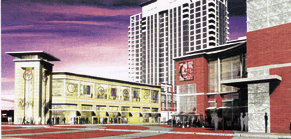
Land Swap Clears Path for Evanston Project A 16-screen movie theater in downtown Evanston? Hard to believe, but it may happen - along with a shopping center, new apartments and perhaps even a new hotel as parts of a complex proposed by the city of Evanston and a private developer. Plans are moving ahead rapidly for a $94 million retail/residential/entertainment center in the Northwestern University/Evanston Research Park. Located between Chicago Transit Authority and commuter rail tracks near Church Street, the complex is a project of Arthur Hill & Co., a major real estate developer. The development will require the relocation of two popular longtime eateries on Church Street, Dave's Italian Kitchen and the Pineyard Chinese restaurant. However, the new area promises to bring a multistory shopping mall, several new restaurants and the multiplex cinema to a part of downtown Evanston that currently consists mainly of parking lots. The property for the project, which will be known as Church Street Plaza, became available after Northwestern agreed with the city of Evanston to trade the University-owned land for a smaller parcel in the northwest corner of the research park near the commuter railroad tracks. That understanding cleared the way for the city to continue working with the private developer on the complex. Northwestern does not yet have specific plans for the development of its property. The research park, a joint venture between Evanston and Northwestern, was started nearly 20 years ago. It has been successful primarily by providing incubator space for technology-related startup companies. The municipality has already diversified the use of the land with some residential development carved from unimproved portions of the park and will expand on that concept with the new project. In doing so, Evanston hopes to add the property back to the tax rolls as well as bring in more sales tax dollars. The first phase of the Church Street Plaza construction is scheduled to begin later this year, with completion in late 2000 or early 2001. |
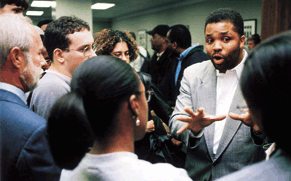 |
|
| "Fears are part of the natural
progression
of maturing,
and they're
opportunities
for growth.
As children grow, they're trying to deal with their excitement and become more
confident, and fears are a part
of that." Linda Rubinowitz, adjunct assistant professor and psychologist at the Family Institute, in the Palm Beach (Fla.) Post
|
Reliable Sources Gifts enable Medill to organize mover-and-shaker lecture series Thanks to the generosity of two Northwestern alumni, students, professors and other staff members are hearing the news straight from the source on campus these days. A $1 million gift from Rance Crain (J60) and a seed endowment from Dillon Smith (J63, GJ64) have lured several prominent journalists and newsmakers to a lecture series organized by the Medill School of Journalism. Former White House press secretary Mike McCurry, Washington Post reporter (and now editor) Bob Woodward and U.S. Rep. Jesse Jackson Jr. (D-Ill.) were among the first speakers to come to the campus (and be peppered with lively questions). The series will continue throughout the next 10 academic years. Crain, president and editorial director of Crain Communications Inc., made the gift in memory of his parents, the late Gertrude and G.D. Crain. "They would enjoy watching the sparks fly," Crain said in an interview with the Medillian, Medill's alumni magazine. Other speakers have included White House special counsel Lanny Davis, Chicago Tonight host John Callaway and journalist and civil rights crusader Roger Wilkins, who spoke on the Rev. Martin Luther King Jr.'s birthday. |
|
Preeminent Domain University explores academic options in push for excellence. Northwestern faculty and administrators are taking a fresh look at the University's course offerings and academic structure. The Highest Order of Excellence, an academic vision statement for the University, was unveiled last year. That document outlined eight intellectual domains for Northwestern: cognitive sciences; communications; economic, international and social studies; humanities; life and biomedical sciences; management and policy studies; materials sciences; and performing and creative arts. All year, the University has held a series of "domain dinners" for faculty from a wide range of disciplines to focus on each of the areas. "Our hope is that these dinners helped build a sense of faculty community across departments and schools," says provost Lawrence Dumas. In addition, an 11-person committee has been established to oversee the implementation of the initiatives outlined in the Highest Order of Excellence. | |
| "It does things that journalism schools can't do
for you. You have to go out and look
at a body on the sidewalk." George Harmon, professor of journalism, in the Washington Post, on the experiences of rookie journalists at the City News Bureau of Chicago, a century-old wire service that closed March 1 but was reorganized as the New City News Service |
Global Reach International affairs journal debuts. Northwestern students have never been shy about tackling big subjects. Now some of them are taking on the world with the mid-February debut of the Northwestern Journal of International Affairs. Loosely based on a similar Harvard University magazine, the new quarterly reflects the University's increased concern with international issues, according to Lee Huebner, one of the journal's advisers and a speech and journalism professor. The 55-page winter issue features articles from Chicago Tribune senior correspondent Richard C. Longworth, University President Henry S. Bienen and several Northwestern professors. The journal hopes to serve as a midpoint between traditional, mass-circulation publications like Newsweek and the more technical periodicals such as the American Political Science Review. "I wanted to bridge the gap between harsh academic mumbo-jumbo, technical language and the superficiality of some news magazines," says senior Leonardo Martinez, the magazine's editor-in-chief. "International affairs is no longer just the province of the informed elite." Funding for the journal was made possible by the Center for International and Comparative Studies, the Department of Political Science and the Office of the Associate Provost for Undergraduate Education. It was distributed to Northwestern students and faculty, students at other Midwestern and top-flight universities, at academic and public libraries, and to many non-governmental organizations concerned with international affairs. |
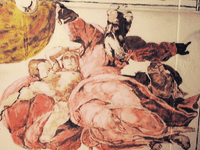
Holy Smokes! Call it the finger of God or the art of compromise. Over winter break, Northwestern officials and sophomore Ryan Du Val agreed to an out-of-court settlement over the future of the young artist's version of the Sistine Chapel, which he painted in six days last fall on the ceiling of his Bobb-McCulloch Hall dorm room. The University is allowing the School of Music student to keep the objet d'art intact until the end of the academic year, but then it goes. Du Val, as nonplussed as Northwestern by the amount of media attention the story received, will pony up to $450 for the repainting job. The student also will be permitted to hire a contractor to see if the work can be moved and preserved elsewhere. Almost everyone acknowledges Du Val did a good - and faithful - job in replicating portions of Michaelangelo's masterpiece. One discrepancy did crop up, however: Instead of God's digit reaching out to Adam, the Evanston version has Him pointing to a smoke detector. | |
|
Online Applications Accepted Applying to Northwestern is now as simple as the push of a button. Well, not exactly, but the University's online application service does promise to make that stressful undergraduate application process just a little easier. Online applicants do their thing through CollegeEdge, a service used by many prestigious universities. In the fall, 947 students applied to Northwestern online, while the other 14,500 applicants opted for the traditional handwritten application. Rebecca Dixon, associate provost for University enrollment, hopes that more students will use the online method, but she adds that Northwestern will never have just one means of applying for entrance. | |
 |
|
| 50
years ago Shakespeare, gum, Reds occupy college thought - March 30, 1949
Coeds reject three-date rule for kissing
12 nations sign [NATO] alliance: professors
commend new pact
Bob Wilson signs with Red Sox: Bonus player tag placed on NU star
Draft slows, jobs boom for potential '52 grads
25
years ago
New emphasis in NU's women's sports
Prof to discuss
'sexual ideology'
10
years ago
Groups set
first AIDS week
Bell clapper kidnapped in weekend tower caper
ASG to consider dorm condom machines
Israeli-Arab debate set; former official, NU prof to examine peace plans
|
Times Past Greek (and Non-Greek) Mythology As the January 1999 blizzard roared through Chicago, Northwestern students trapped by the bad weather in airports around the country wondered if the school would open for classes as scheduled on Jan. 4. Most assumed it would, even if there were no students on campus to attend classes. "I've heard that Northwestern doesn't close for anything," says Alison Rezabek, a freshman in the School of Speech. Sheppard Shanley, senior associate director of admissions, says this common myth is simply untrue. "Rarely, yes. Never - you can never say never," he says. "Twenty years ago in January, there was a much larger blizzard. I think that classes were canceled on at least a Monday and maybe a Tuesday." The belief that Northwestern never closes is one of many misconceptions that have been passed on by University oral tradition. Many can be heard on other college campuses around the country. One widespread myth at many schools, including Northwestern, is that their libraries are slowly sinking because the architects failed to consider the weight of the books when they designed the building. "Remember, myths are believed because they're credible," says University archivist Patrick Quinn. "The reason [the library story] has credibility at Northwestern is that the [Deering Library] is built on the lakefill." Another common story in Evanston is that the administration building, the Rebecca Crown Center, was built to withstand a possible attack from student protesters. Quinn says this rumor is circulated on almost every college campus with buildings dating from the 1960s, when student seizure of university buildings was fairly common around the country. In the capital improvements vein, one long-standing story asserts that if every student in the South Quads flushed his or her toilet simultaneously, the ground in the quads would erupt in a geyser. It's a fabulous concept that just doesn't hold water, says Jeremy Wilson, recently retired associate provost. Quinn credits campus tours for prospective students and the traditions of fraternities and sororities with spreading these myths. He himself has overheard tour guides telling untrue stories. "The structural mechanism that keeps myths alive is the constant flow of students in and out of the school," says Quinn. Illustrating this point is the fable that the Foster-Walker Complex, a primarily single-room dorm with more than 600 undergraduate students, was built by an architect who designed prisons. It's also untrue that housing office planners whimsically assign people with the names of buildings on campus to the same room or suite, says Mark D'Arienzo (S84, GS91), assistant director of university housing administration. The fact that a dorm suite was once full of Fosters, Walkers and Scotts, or that a Jim Morrison (J83) - no known connection to the deceased rock star - was once assigned to room with a John Lennon is purely coincidental. "That was just the way it worked out," D'Arienzo says adamantly. "We don't assign people with the names of dead celebrities together. It's a good idea, but we don't have time to have fun." In addition to myths, stories do circulate around campus that sound fictional but actually have a basis in truth, such as the common belief that a network of tunnels exists under the campus. In fact, a tunnel that is no longer in use does connect Leverone Hall and the library, according to Quinn. D'Arienzo says tunnels connecting the Crown Center to the bursar's office and Allison Hall are still used. The rumor that graduate students have lived in the Technological Institute is also based on fact. Joel Meyer, associate dean of the McCormick School of Engineering and Applied Science, says in the early 1950s, a graduate student with a sleeping bag and an electric heater managed to crawl into a space underneath a stairway. His plan was foiled when his sleeping bag got caught in the heater and started a fire. Luckily, the student wasn't there at the time.
- AnnMarie Harris (J00) |
|
Deaths Robert E. Machol and Edmund F. Perry Robert E. Machol, 81, professor of systems at the Kellogg Graduate School of Management for 20 years, died Nov. 12 at Bethesda Naval Hospital in Maryland. During his career, he was a consultant to NASA, the Office of Naval Research and the U.S. Department of Defense. In 1957, he co-authored Systems Engineering, one of the first authoritative texts in the field. Not content to be idle after his retirement from Northwestern in 1986, Mr. Machol embarked on a second career as chief scientist for the Federal Aviation Administration. Early in his tenure there, he researched potential dangers to small aircraft created by wake turbulence from the Boeing 757. Eventually, the FAA ordered landing aircraft to increase their distance behind the jetliners. He is survived by his wife, Florence; two children; a brother; and four grandchildren. Edmund F. Perry, 75, professor emeritus of religion, died Dec. 14 in Evanston. A member of the Northwestern faculty since 1954, Mr. Perry served as chair of the Department of History and Literature of Religions (now the Department of Religion) for many years. After earning a doctoral degree in 1950 from Northwestern, he taught at Duke University for four years before returning to Northwestern. Mr. Perry's interests in world religion led him to the study of Buddhism. A Christian theologian, he spent his career seeking to understand Buddhists as they understand themselves. An ordained Methodist minister, Mr. Perry was known for challenging his students and, when appropriate, carefully tending to their personal needs. He authored several books, including The Gospel in Dispute, Confessing the Gospel and A World Theology, as well as numerous scholarly articles. He is survived by his wife, Lena; three sons; and three grandchildren. | |
|
Other Deaths Cyrus DeCoster, 84, professor emeritus of Spanish, Jan. 29. Jack M. Pernecky, 76, associate dean of graduate studies in music, Dec. 2. George Shambaugh Jr., 95, professor emeritus of otolaryngology, Feb. 7. | |
|
Sesquicentennial News Alumnae to Endow Professorship In honor of the University's upcoming Sesquicentennial, the Alumnae Board of Northwestern University is establishing an endowed teaching professorship. The endowment - with a goal of $500,000 by the sesquicentennial year of 2001 - will recognize a faculty member for excellence in teaching and for developing innovative new curricula. The Alumnae Professor may be selected from any school in the University that has an undergraduate enrollment. "This contribution is particularly appropriate because we use some of the top faculty members in our continuing education program," says Louise Stewart Yao (N62), president of the Alumnae board. "We know how good our professors are at Northwestern." The appointment will be for three years, during which time the recipient will receive an annual salary supplement and a discretionary professional account. To select him or her, the provost will establish an advisory committee to recommend a candidate from those nominated by deans of the schools and the college. A major portion of the funding, $351,000, comes from early gifts and a transfer from the Alumnae Professor Award for Curriculum Development, which the new professorship replaces. "We're delighted to play this role in anticipation of the University's sesquicentennial celebration," Yao says. The Alumnae Board of Northwestern University, which dates back to 1916, is the oldest constituent group in the Northwestern Alumni Association. | |
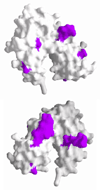 |
Lab Notes Sneeze Slayers Researchers at Northwestern and Harvard Medical School have determined the precise shape of the receptor molecule that triggers the allergic response in the immune system. This was the first structure reported for a member of this family of antibody receptor proteins. The finding, expected to lead to the development of a new class of drugs for allergy and asthma sufferers, was reported in the Dec. 23 issue of the journal Cell. The research was funded by Heska Corp., the National Institutes of Health, the Pew Scholars Program in the Biomedical Sciences and the American Cancer Society. |
|
Net Cadets Northwestern and IBM, with support from Ameritech, Cisco and other corporate partners, have established a new research center to advance next-generation Internet technology. The center, which opened last fall, will establish strategic initiatives focused on advanced application design, new network services and network performance. It will showcase examples of innovative technology solutions for the industrial sectors, corporate processes, education and personal communications. The center will have multiple sites on the Northwestern campuses in Evanston and Chicago and at IBM facilities. | |
|
Boning Up A group of Northwestern scientists and doctors have formed a network to share knowledge on diagnosing, treating and preventing bone disease. The Northwestern University Bone and Osteoporosis Network, or Bone.nwu., has grown from five to almost 60 University scientists, physicians and educators. "We have the potential to raise questions from different subspecialties and add to each other's individual expertise," says Paula Stern, a professor of molecular pharmacology and chemical biology. "We also brainstorm with each other about how to give bone health a more prominent public face." | |
|
Microwavers A novel breast cancer imaging technology using microwaves instead of X-rays to detect breast tumors is being developed by Northwestern, the University of Wisconsin - Madison and Interstitial, a startup company in the Northwestern University/Evanston Research Park. The new technology is based on a different principle than X-ray mammography, which shadows potential tumors by passing high-energy radiation through the breast to expose film on the other side. With the microwave approach, a miniature antenna is put in contact with the skin surface to bounce extremely low-energy microwave pulses off potential tumors. | |
|
Speed Demons Researchers at the Medical School have greatly improved on a method used to diagnose an antibiotic-resistant bacteria seen in hospitalized patients, reducing from 48 to eight hours the time needed to identify the potentially lethal bacteria, known as vancomycin-resistant enterococci. According to the Atlanta-based Centers for Disease Control and Prevention, because VRE are immune to all currently available antibiotics, it is vitally important to isolate patients with VRE as quickly as possible. Valentina Stosor, a clinical instructor in the Department of Medicine, is the lead investigator on the study. | |
|
White Lightning A Northwestern team has provided the first demonstration of lasing in a simple powdered material, suggesting that cheap semiconductor lasers could replace some of the estimated 30 billion light-emitting diodes used each year in cell phones and calculators. The researchers' observations showed that powdery layers of zinc oxide and gallium nitride can produce blue laser light when the powder is "pumped" with light from another laser. "If a zinc oxide laser device ultimately works, it could replace LEDs in luminescent display devices because the light would go in all directions with much greater efficiency," says Hui Cao, assistant professor of physics and astronomy. | |
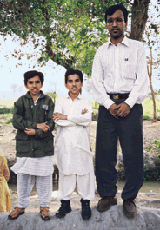
Researchers Find New Form of Dwarfism Gerhard Baumann, professor of endocrinology in the Medical School, and Hiralal G. Maheshwari, former senior research associate, have identified a new, genetically inherited form of dwarfism now called Dwarfism of Sindh. After compiling multifactorial data near Karachi, Pakistan, where a cluster of dwarfs lived, the researchers found that this syndrome is the human genetic counterpart of one in certain mice that causes an underdeveloped pituitary, growth hormone deficiency and a dwarfed body. The findings were recently reported in the Journal of Clinical Endocrinology and Metabolism. | |

Gifts & Grants William (CB66) and Jan (S71) van Straaten have donated more than 100 works to the Mary and Leigh Block Museum of Art. The gift is the museum's largest ever of contemporary art. Founders of Riverhouse Editions, a publisher of fine art prints based in Clark, Colo., the van Straatens have given "college proofs," a unique collection of etchings by artists who have worked at Riverhouse since 1992. "The gift includes an impressive array of contemporary artists who have had a major impact on the art of our time," says David Mickenberg, director of the Block Museum. Riverhouse Editions is a fine arts press led by one of the country's finest master printers, Susan Hover. In 1992, Riverhouse made the unusual decision to reserve one print from each new edition as a college proof to be placed at a later date with a college or university to teach about the art and technique of printmaking. Each print is marked with the designation "CP." The donated collection will be the subject of a major exhibition at the museum in September 2001. | |
|
Campaign Northwestern Building Boom Under Way It hasn't taken long. Results of the University's $1 billion fundraising effort, Campaign Northwestern, are already visible on the Evanston campus, just under a year after the campaign was announced. An $8.6 million lakefront residence hall is scheduled to open for the 1999-2000 academic year; the fourth floor of Annenberg Hall, originally unfinished space, is undergoing a $4.5 million completion; and a new $800,000 indoor golf facility inside Patten Gymnasium is nearly ready for use. Gifts from the Kemper Educational and Charitable Fund for the new residence hall (named in honor of James S. Kemper), from Edwina S. Tarry (GSESP38) for the Annenberg completion and from Eric Gleacher (WCAS63) for the golf facility were instrumental in getting these projects under way quickly. More than a dozen building projects are on the drawing board for the Evanston and Chicago campuses. One of the primary goals is to raise $262 million for new academic and student life facilities. Plans in Evanston include a new Transportation Center; a laboratory for biomedical research; a nanofabrication facility for researchers to develop synthetic soft tissues; a new broadcast journalism building; and expansions to Arthur Andersen Hall (for the economics and management faculty) and to the Mary and Leigh Block Museum of Art. New buildings to support the expansion of medical faculty in existing departments and the establishment of a department of genetics are planned for the Chicago campus. Commitments are nearing $625 million as the campaign completes its first year of public activity. From the start, President Henry Bienen and a team of faculty, staff and students have traveled to U.S. cities where there are concentrations of Northwestern alumni and friends, spreading news of the University's plans. Campaign Northwestern aims to achieve a number of goals beyond raising money. One - strengthening ties with alumni - is reflected in the establishment of a network of campaign volunteers. Campaign subcommittees are working with each of the University's schools to identify prospects and solicit gifts for campaign objectives; similar subcommittees are assisting in the areas of athletics, the library and student life. Subcommittees have also been set up to boost corporate, foundation, parental, faculty and alumni annual giving. Every regional event has been organized with help from a local committee. Campaign leaders describe their committees as "in formation," so new volunteers are welcome. Another goal is to increase participation in annual giving by alumni. Participation - the number of alumni who make an annual contribution of any amount to their alma mater - is a statistic often used in national ranking formulas to gauge the satisfaction of alumni with their educational experience. Alumni giving at Northwestern has hovered at around 30 percent for many years, compared with 40 to 50 percent at other top-ranking institutions. Campaign officials hope that interest in advancing the University's national reputation will tap a competitive spirit in alumni and boost Northwestern's annual giving participation rate to 40 percent or higher over the next five years.
|